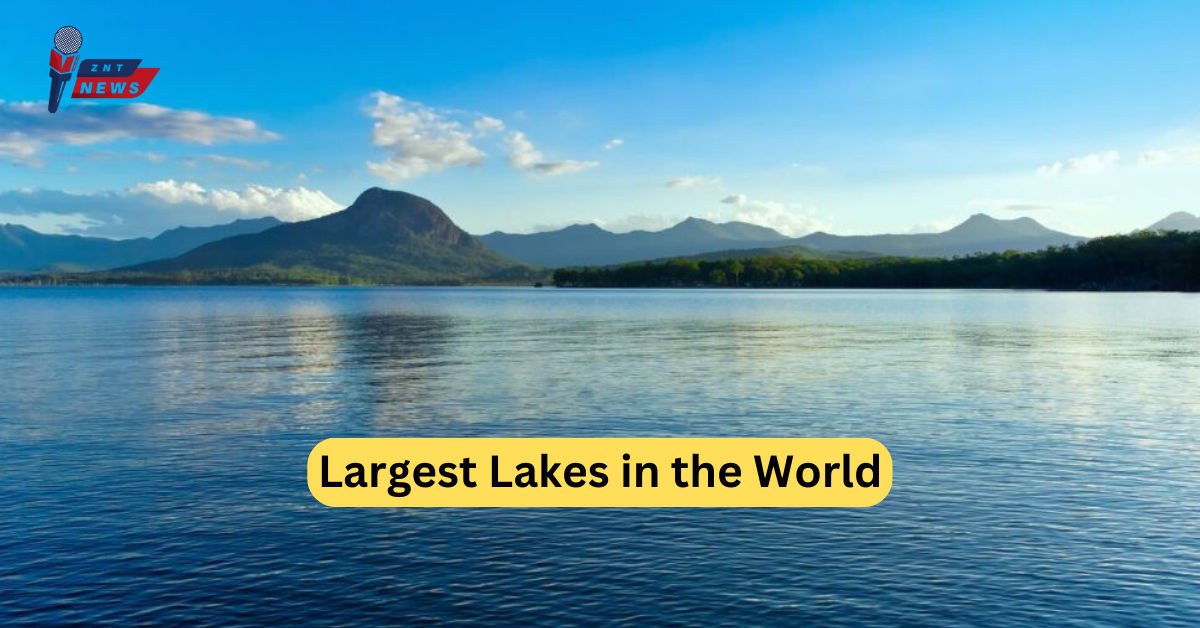Top 10 Largest Lakes in the World: The world is dotted with countless lakes, each with its unique charm and significance. In this article, we embark on a journey to discover the top ten largest lakes globally, unveiling their vast expanses and distinctive features. From the icy depths of North America’s Great Slave Lake to the salty expanse of the Caspian Sea straddling Europe and Asia, these water bodies showcase the incredible diversity of Earth’s natural wonders.
List of Top 10 Largest Lakes in the World

Great Slave Lake (27,000 km2):
Nestled in Canada’s Northwest Territories, the Great Slave Lake claims its spot as the tenth-largest lake on Earth. Boasting a depth exceeding 600 meters, it stands as the deepest lake in North America. With its frozen winter surface facilitating an ice road between Yellowknife and Dettah, this lake becomes a hub for adventurous residents and avid sailors during the warmer months.
Lake Malawi (29,500 km2):
Extending across Tanzania, Malawi, and Mozambique, Lake Malawi ranks as Africa’s third-largest lake. Its claim to fame extends beyond size; it houses a remarkable diversity of cichlid fish, making it a haven for aquatic biodiversity. While some areas allow fishing, several regions are designated as marine reserves to protect the vibrant life teeming within its waters.
Great Bear Lake (31,000 km2):
Canada’s Great Bear Lake, the eighth-largest globally, unfolds its vastness within the Northwest Territories. Surrounded by boreal forest and tundra, this freshwater giant plunges over 440 meters at its deepest point. Known for its crystal-clear waters, it harbors a variety of marine life, although it boasts the fewest fish species among Canada’s Great Lakes.
Lake Baikal (31,500 km2):
Russia’s Lake Baikal emerges as the largest lake by volume on Earth. With a depth of 1,632 meters, it holds the titles of both the deepest and oldest lake globally. Boasting unparalleled clarity, the lake is home to around 1,700 plant and animal species, with its pristine waters fed by snowmelt from the Siberian mountains.
Lake Tanganyika (32,600 km2):
Aptly named, Lake Tanganyika, the second-oldest and longest freshwater lake globally, stretches across four African nations. Forming part of the Rift Valley, its depths are inhabited by Nile crocodiles, adding an element of caution to those contemplating a swim.
Lake Michigan (58,000 km2):
As one of North America’s Great Lakes, Lake Michigan earns its place as the fifth-largest lake globally. The sole Great Lake entirely within the United States, it presents challenges to swimmers with its uneven bottom and the presence of dangerous rip currents.
Lake Huron (59,600 km2):
Connected to Lake Michigan, Lake Huron claims the fourth spot among the world’s largest lakes. Its extensive coastline, spanning over 3,800 miles, harbors a history of shipwrecks, with Fathom Five National Marine Park hosting 22 wreck sites.
Lake Victoria (68,870 km2):
Africa’s largest freshwater lake, Lake Victoria, plays a pivotal role as the primary reservoir of the Nile River. However, its title as the most dangerous lake in the world stems from factors such as black spots, unpredictable weather, and the presence of crocodiles.
Lake Superior (82,100 km2):
Holding the crown as the largest freshwater lake by surface area, Lake Superior reigns supreme among North America’s Great Lakes. Despite its significance for transportation, its depths exceeding 400 meters in some places make it a perilous destination for swimmers.
Caspian Sea (371,000 km2):
The Caspian Sea, despite its name, stands as the world’s largest lake, entirely landlocked between Europe and Asia. Celebrated for its distinctive caviar and a thriving oil industry, this expansive body of water holds a unique position as a partially salty lake, echoing its ancient connection to the Paratethys Sea.
Conclusion:
From the frozen landscapes of Canada to the tropical realms of Africa, each of these lakes tells a tale of geological marvels, ecological richness, and human interaction. As we explore the top ten largest lakes in the world, we unveil the diverse tapestry of nature’s grandeur, inviting us to appreciate the vastness and complexity of Earth’s water wonders.
……………….By ZNT News
